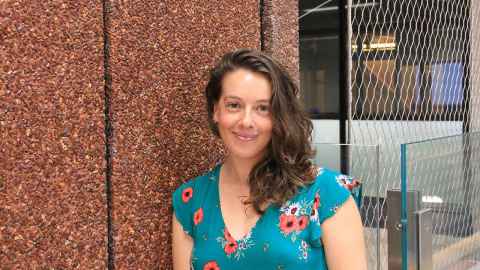Take 10 with... Laura Cobus
Dr Laura Cobus, Department of Physics, gives us 10 minutes of her time to discuss her research on using sound waves to study materials with complex structures.

1. Describe your research topic to us in 10 words or less.
Using waves to study materials that can’t be cut open.
2. Now explain it in everyday terms!
When sound waves travel through different materials, they retain a ‘memory’ of the structures that they interacted with along the way. So, if we want to study an unknown material (one that we can only access from the outside), we can send sound waves in and see how they have changed when they come out. Then we compare this with what we already know theoretically about how waves travel through different materials. This is the basic idea behind medical ultrasound imaging.
Studying materials with more very complicated structures is trickier because, as the waves are scattered before we detect them. To deal with this, we require a better understanding of wave transport in complex media and more sophisticated experiments. I specialise in experiments where we send and receive sound waves at many different locations to get as much information as possible about the material.
I also work with other types of waves. What is lovely about this research area is that different kinds of waves can be described with the same mathematics. This means that experiments for one field – for example, ultrasonic imaging – can, with a bit of work, be applied to a totally different field, like radar or seismology.
3. Describe some of your day-to-day research activities.
On a typical day, I might be in the lab doing an experiment, at my computer working with the data, or coding for numerical simulations. I spend time every morning looking through one or two new papers that have come out in my field. I communicate a lot with other scientists as well. I talk with my current (overseas) collaborators to update them or ask about problems I’m having, and with other researchers to plan future projects or just explore new ideas.
4. What do you enjoy most about your research?
Physics is basically solving puzzles. In my research, I gather large amounts of acoustic signals from a particular system. At first glance these signals just look like a lot of noise. But if we are clever with how we manipulate the data, we can find hidden information, and use that information to make an image or uncover new physics. After all this time, I’m still secretly surprised and elated when our mathematical description of the world turns out to match experimental observations.
5. Tell us something that has surprised or amused you in the course of your research.
Often a ‘mistake’ is actually a cool discovery. When experimental results look a bit funny, I often assume that I have done something wrong, but several times now such a ‘mistake’ has turned out to be new and interesting physics or has led to a good idea for a new experiment.
6. How have you approached any challenges you’ve faced in your research?
I first have a casual chat with another researcher or collaborator. If something really isn’t working, I go back over what I’ve done in detail. Then I make a list of the things I don’t understand or haven’t tried yet and explore them one by one. After that, I reach out to another expert in the field.
7. What questions have emerged as a result?
Tons! I think good research often asks more questions than it answers. Attending a conference last year, I asked a senior researcher to look over a new ultrasound imaging technique I was creating. After suggesting some things to try, he remarked off-hand that my method might be good for a totally different application that I hadn’t even thought of. This has opened a whole new research direction for me.
8. What kind of impact do you hope your research will have?
I hope that my research will have a positive impact on society, even if there is a long delay between an idea for a new technology and actually seeing it commercialized. What I find equally gratifying is seeing my research and ideas integrate with the work of other researchers, participating in the scientific community, and advancing science as a whole.
9. If you collaborate across the faculty or University, or outside the University, who do you work with and how does it benefit your research?
Currently my main project is imaging moving environments. I’m working with two overseas researchers and their groups: Stefan Rotter’s group in Vienna, which helps with the theoretical aspects, and Alexandre Aubry’s group in Paris, which helps more with computational methods and some experiments. Here at the University, two summer students recently performed numerical simulations and built some experimental equipment for us. I also work with photoacoustic imaging expert Dr. Jami Shepherd. We help each other with ideas, experiments, and supervision. Jami and I have lots of ideas for collaborations, and just need to find the time to start some larger projects.
10. What one piece of advice would you give your younger, less experienced research self?
It is always good to have a clear goal in mind when starting a project. I think that at undergraduate, and even graduate level, we’re not really taught how to plan projects to achieve specific goals. Luckily, I have had some great supervisors who modelled that behaviour, but it still took me a while to figure out how to do that for myself.
And if I can sneak one more in: have confidence in yourself! Starting at a new lab can be intimidating especially being one of the only women there, but you will have more success if you have the confidence to ask questions and to put forward ideas.